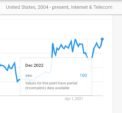SEO is alive and kicking in 2023 – and beyond

SEO is alive and kicking in 2023 – and beyond
Even as Google and Microsoft reinvent search with AI-powered features, search engine optimization is here to stay.
Demand for SEO has been growing yearly based on Google Trends and Exploding Topics data. For many businesses, organic search reach is still a significant source of traffic, leads and sales.
Despite this, there’s no visible optimism within the industry. Some say the brewing economic crisis will hit the SEO industry first and hardest, with a few high-level firings of top SEO executives and industry leaders having fueled such fears.
This reminds me of a famous quotation on optimism vs. pessimism attributed to Henry Ford:
“Whether you think you can, or you think you can’t – you’re right.”
A self-fulfilling prophecy works that way. When you don’t think you can make it you won’t even try or sabotage yourself while at it. When you believe it can be done on the other hand you will excel and make it happen despite some roadblocks.
That’s why it’s important to view the situation optimistically or at least realistically. At the moment, we’re still seeing an increasing demand for SEO services and corresponding employment opportunities. Yes, SEO is alive and well.
SEO is no longer just technical
Over the years, SEO has been increasingly labeled as technical to distinguish itself from other disciplines and to justify the investment. Yet, in reality, SEO is much more than ensuring crawling, indexing and rendering or taking care of canonical tags and rich results.
Often 80% of the actual SEO work is about content and social tasks. Content SEO usually gets labeled as content marketing or simply publishing and assigned (wrongly) to other teams completely while social SEO is not (just) about social media really but rather about social relations with people who will likely link to you:
- Website owners.
- Bloggers.
- Journalists.
- Editors.
- Publishers.
You have to build relationships with actual influencers before asking for favors, especially big ones like a link. In a way, actual outreach is only the last step of proper social SEO.
Get the daily newsletter search marketers rely on.
See terms.
Social media traffic is not enough
One reason SEO was said to be dead is social media traffic. During its heyday, Facebook drew more visitors to publishers than Google did – a trend that has been reversed since 2017. Fast forward to 2023, organic search traffic dominates while social media traffic continues to dwindle.
It’s not an either-or anyway.
Nowadays, SEO and social media go hand in hand – although much less obvious than a few years back when Google+ and authorship markup were clear indicators of social search. Despite Google giving up those two and other social tools and features search is inherently social in nature.
Just think of these benefits:
- Twitter can improve your visibility directly on Google.
- Facebook updates are more public than they used to be.
- Popular content on social media is much more likely to attract links naturally.
Otherwise, you have to invest a lot in outreach and other PR efforts.
While I was a big proponent of social media as early as 2007, I eventually realized that it doesn’t work by itself without search engines. They have different yet complementary roles.
Social media is needed to discover new things while search is used in the final steps of the customer journey. Searching for something is impossible if you don’t even know it exists. You have to discover something new outside of search first to take an interest in it and finally search for it.
Once people buy, the conversion or sale often gets attributed to search. We know this is just a small part of the truth as this form of attribution overvalues the last click.
That said, shoppers rarely buy on or through social media directly. The customer journey often starts on social media or elsewhere:
- Real life (word of mouth, billboards).
- TV and radio (including streaming).
- Print (magazines, newspapers).
We know there are at least a few “touchpoints” until a person decides to search for something and even then the search query will most likely be informational at first, then navigational and transactional only toward the end.
Social SEO also works in real life when family, friends and colleagues recommend you and your products or services to someone else. They won’t buy your product from these people though, neither offline nor online. They still have to search for it.
The demand for SEO: What data tells us
Among the many changes the COVID-19 pandemic brought about is the rise of all things digital, reshaping how people live and work. Remote work and online shopping are the new norms now and in the foreseeable future.
As such, marketers who can support businesses in navigating the digital landscape are sought after. SEO is no exception.
The growing demand for SEO services and expertise persists in 2023. Let’s look at the data.
Google Trends
Demand for SEO has been growing for a few years, according to Google Trends data.
!–>
!–>
Read More
Be the first to write a comment.



